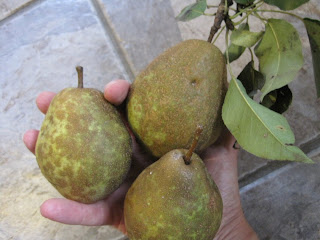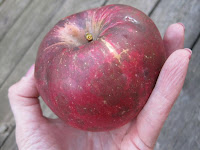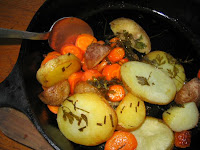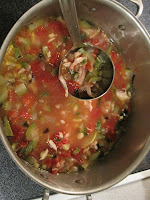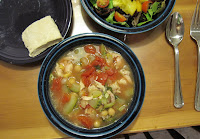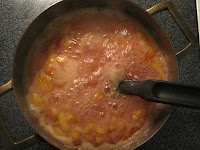
This time of year, on the New Jersey coastline, the warm waters of Barnegat Bay contrast with newly-crisp morning air, and brisk breezes whip frothy whitecaps into the water surface.
Nestled in their mud and sand homes live
clams. My family loves clams. I think it's genetic, because I love clams too. Nick, to whom I've been married for almost 25 years, has come to tolerate clams. He will eat them, but he does not love clams. I love the scientific name of clams -
Mercenaria mercenaria. This name references their role as "money". The first Americans (pre-European invasion) traded in clams, as food (dried) and used their shells, which are beautiful purple, white and gold, inside, as a form of money.
Clams are precious. So humble, simple, living in sand and mud, under the surface of the bay. Biologically, clams have changed little since the
Cretaceous period. Fossils exist of creatures which are largely similar to our modern Mercenaria mercenaria.
Clams were initially scorned by early European immigrants to the United States as 'low' food. Northern Europeans deemed clams suitable only for eating by the lower classes. Now, clams are appreciated as a culinary delicacy by many, most certainly, members of my family. My mom and dad make clam patties, clam fritters, clam chowder, clam spaghetti, and my dad makes a killer 'clam egg'. When my parents go on trips, they take two clam rakes with them, they like clams so much.
I have read that clams move no more than 4 inches in their lifetimes. Well, silly me, why should that surprise me? They have a foot, but no legs. Clams stay buried in the mud, siphons up, filtering the smallest sea creatures and synthesizing the plankton into my lovely, sweet, edible nuggets of culinary delight - clams. This time of year, in September, the clams we dig from Barnegat Bay are more luscious than at any time of year. They're fattened up from all that rich plankton which forms in the warmth of the summer.
Warm is good, to a point. The clams seem to like it, but some other creatures who share the bay don't. B
lue crabs are not happy when the water gets too warm, because their breathing apparatus is similar to that of insects - kind of a passive oxygen transfer system. Warm water holds less oxygen. Crabs need lots of available oxygen in the water, or they suffocate. Earlier this summer, there was a huge crab kill on Barnegat Bay. The water was so warm, the oxygen levels were depleted below the crabs' tolerance. The water is cooler now, and there are crabs in the bay again. I guess the new crabs must have come from other areas - through the inlet (from the ocean) or from neighboring bays.
Like many bodies of water, Barnegat Bay is getting warmer, due to development and in part due to the existence of
Oyster Creek power station. Oyster Creek uses the waters of the bay to cool its reactor, sucking in and out 10 times the volume of the bay each year. Oyster Creek has been around since the 1960s, and is not the sole reason that the Bay is warming. A combination of nitrogen runoff (causing algae bloom), and other development pressures, along with Oyster Creek, makes the Bay warmer. The public loves water, and I love clams. We need to keep working together to preserve our ecosystems, including the Bay. Progress is being made - things look better for the environmental future than they did in the 1970s for sure. So, on to clam spaghetti.
We dug the clams used for clam spaghetti a day before we used them. After digging the clams, we hang them in a basket, suspended off the side of the dock, so that they're dangling in the bay, in clean water. So, the clams continue eating, but they expel the grit that they normally have inside them, because they're not living in sand and mud anymore. If I lived 1 inch below sand and mud, I'd be full of grit, too. Once the clams have cleaned themselves, it's time to bring them in for the harvest.
No surprise - you've got to open the clams to start making clam spaghetti. Clams are easier to open if they are cold. My parents taught me to chill them down in the freezer for about 15 minutes. The clams get sleepy in the freezer and are less resistant to being opened. The clams, being living beings, don't want to die. I don't blame them, so I try to make it as easy for them as I can. So the freezer is a primitive form of anesthesia. You get the clams sleepy from the freezer, then open the clams by taking a knife, inserting it in the side front of the clam, then sweeping the knife inside the clam, to sever the muscle that holds it closed. Once you have done that, the clam gives up, and you scrape it from its shell.
I was cooking to feed five people, so I used 30 clams in this recipe- medium to large sized. The large "honkers", I reserve for clam chowder, but you can use them if you want. I save the smaller clams (1 1/2 inch to 2 inch) for eating raw on the half shell, or to steam.

Next, take 2 cloves of garlic, or as much as you want, if you're a garlic lover, and cook (don't brown) in 1/2 stick of butter. I used unsalted, but if all you have is salted, use it. (Use less butter, if you're making a smaller quantity - remember I was cooking to feed five adults). Soften the garlic, stirring constantly, in the pan. Remember, do not brown the garlic! Last night, when we made this dish, my sister Leslie stirred the butter and garlic for over 10 minutes, only to have me come into the kitchen, turn the heat up, and burn the garlic. We had to dump it out and start over again. Learn from my mistake -go gently with the heat, and you'll not burn the garlic.
Meanwhile, drain most of the liquid from the clams, then chop the clams. (Do not grind them). I used a pair of old kitchen shears for this job. You can reserve the clam juice, if you want, for another use. Be aware that the clam juice is very salty (as are the clams...but the juice has a LOT of seawater in it). You're going to put the clams in at the very end, just as your pasta has 3 minutes to go. Because you do not want to cook the clams hard. You want to only warm the clams and turn them from translucent to cooked, right before serving. If you cook the clams hard, you'll end up with little rubber bands, not clams.

Chop your parsley. This is my sister, Leslie's hand at the beginning of her chopping sequence. The parsley was from my mom's beautiful shore garden, which includes assorted herbs, marigolds, phlox, cosmos, zinnias, and such. The garden is right outside the back door, on the way to the dock.
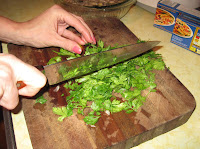

Right when your pasta is finishing up, around at the three-minutes-to-go mark, add your chopped clams, and cook for about 2 minutes. Then, add some heavy cream. Not much - just enough to smooth it out. For five people, I used 1/2 cup. Then, add the chopped parsley, and...
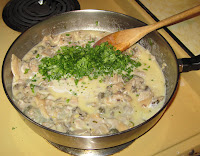
if you have it, about 2 ounces good quality white wine (we used a nice unoaked chardonnay).Stir, warm, and you are ready to mix it with your drained, cooked pasta. Mix the pasta and the clam mixture well, tossing to cover all the noodles. Reserve some of the clam mixture to put on top of your finished dish, before serving, for appearance's sake.

Many people make clam spaghetti using olive oil, instead of butter and cream. I like the butter and cream more than olive oil, as these seem to 'soften' and complement the flavor of the clams. Use some pepper on the final dish. You won't need salt.
Thanks to Mary and Leslie for culinary assistance and photographic documentation!

